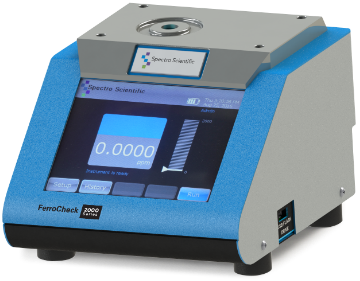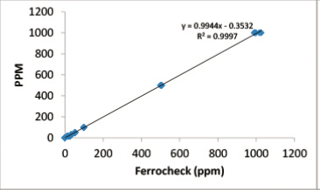Historically, one of the most cost-effective indicators of machinery health has been the analysis of ferrous debris in oil. Such analysis utilizes the ferromagnetic properties of generated debris to perform the analysis. Since nearly all wear debris contains ferrous material (in particular iron), an abnormal increase in the amount of debris can be directly correlated to abnormal machinery conditions in the vast majority of cases. One type of ferrous debris analyzer is the magnetometer. The device works by sensing the disruption of a magnetic field that is generated due to the presence of magnetic particulates in the oil. Since the ferromagnetic properties of iron are well-known, the amount of disruption may be directly quantified to a certain amount (ppm) of iron. Devices such as the FerroCheck operate on this principle.

The device has several advantages relative to other means of debris analysis. By its very nature the Ferrocheck is sensitive at the single ppm level to ferrous debris, it requires no sample preparation of the 3 ml of oil and it can provide answers in seconds. Since the magnetic field generated by the device is so small, the FerroCheck is portable and can operate off an embedded battery. To simplify operator sample handling, the FerroCheck analyzes oil in a disposable plastic syringe that may be directly obtained from a standard oil bottle without further preparation. Upon measurement completion in ~30 seconds, the syringe may be disposed and the oil may be returned to the bottle if necessary. Note that with this mode of measurement, the FerroCheck may also be used to measure greases.
Magnetometers for oil analysis come in two general flavors: Those tuned to the detection of single particles in a flow stream of oil and those for the detection of the total amount of ferrous debris in a static sampling of fluid. Both use the same principle of measurement but are typically tuned to the particular mode of measurement by (a) the geometry of the oil sample when analyzed, and (b) the signal processing of the magnetic field disruption. It should be noted, as in the case of the LaserNet 230, that these two general measurement modes may be mixed. In the case of the FerroCheck, the geometry is optimized to provide single ppm sensitivity with the minimum amount of fluid. When the syringe drops into the FerroCheck measurement chamber, the disruption of the magnetic field is immediate, as shown in the graph. The FerroCheck is phase-sensitive and so it can distinguish between disruptions in the magnetic field due to ferromagnetic particulates and disruptions due to inductive currents generated by highly conducting samples (such as aluminum). The amount of ferromagnetic disruption is then immediately related to the amount of total ferrous material. This total amount is not sensitive to size distribution of the particulate but rather only the total mass of magnetic material, which is assumed to be primarily iron.
The FerroCheck is phase-sensitive and so it can distinguish between disruptions in the magnetic field due to ferromagnetic particulates and disruptions due to inductive currents generated by highly conducting samples (such as aluminum). The amount of ferromagnetic disruption is then immediately related to the amount of total ferrous material. This total amount is not sensitive to size distribution of the particulate but rather only the total mass of magnetic material, which is assumed to be primarily iron.
The FerroCheck can sense the total amount of debris between 0-2000 ppm of material. Again by the nature of this magnetometer based device, the accuracy of the measurement remains high across the measurement range, as illustrated in this curve. This is counter to the case in elemental analysis systems, where more material generally leads to a more complex signature to analyze. In fact, the range of the measurement is only limited by the sensitivity of measurement needed and the range limits of the analog-to-digital converter used. These systems can be linear up to percents of ferrous material in the oil.
This is counter to the case in elemental analysis systems, where more material generally leads to a more complex signature to analyze. In fact, the range of the measurement is only limited by the sensitivity of measurement needed and the range limits of the analog-to-digital converter used. These systems can be linear up to percents of ferrous material in the oil.
The particular magnetic design and signal processing approach of the FerroCheck is tailored to provide a device that is insensitive to temperature over its range of operation. Similar to the LaserNet 230, the device uses four coil windings on two coils, two each for sense and driving (generation) of the magnetic field. The drive windings are wired in series so that the identical current flows through both coils, while the sense windings are wired in anti-series so that with no sample the output of this magnetometer is essentially equal to zero. The syringe is inserted into one coil only, and so the actual signal generated is always the difference between two identical coils, one with the oil sample and one with no oil sample. This greatly stabilizes the measurement and enables repeatable ppm-level detection.
To process the output of the FerroCheck into a ppm reading, the device uses the response of both the physical insertion of the syringe (via position sensors) and the electromagnetic response (the signal from the magnetometer itself). This allows for accurate determination of the time at which the oil enters and exits the measurement chamber. Further, since the two events (insertion/removal) are both monitored, a double measurement of the amount of ferrous material is made each time the sample is inserted and removed. This redundancy further enhances the accuracy and error-checking capabilities of the FerroCheck. Since in both cases (insertion/removal) the electromagnetic response is instantaneous, a third response, that of the non-magnetic channel of the FerroCheck, may be used to sense and correct any temperature-induced variations in the signal at the time of measurement in the magnetic channel, since variations in the signal outside the insertion and removal times is temperature-related. This is particularly important if the sample is fresh off machinery and is hot, for example.
The FerroCheck is a unique device that takes advantage of the extreme simplicity and sensitivity of coil-based magnetometer systems, while at the same time building in ancillary sensing and advanced signal processing
methodologies to ensure the raw response of such a system is stable with regard to temperature. In addition to an intuitive, large touchscreen interface and simple navigation, the device is built for field operation by maintainers at all levels of experience.

